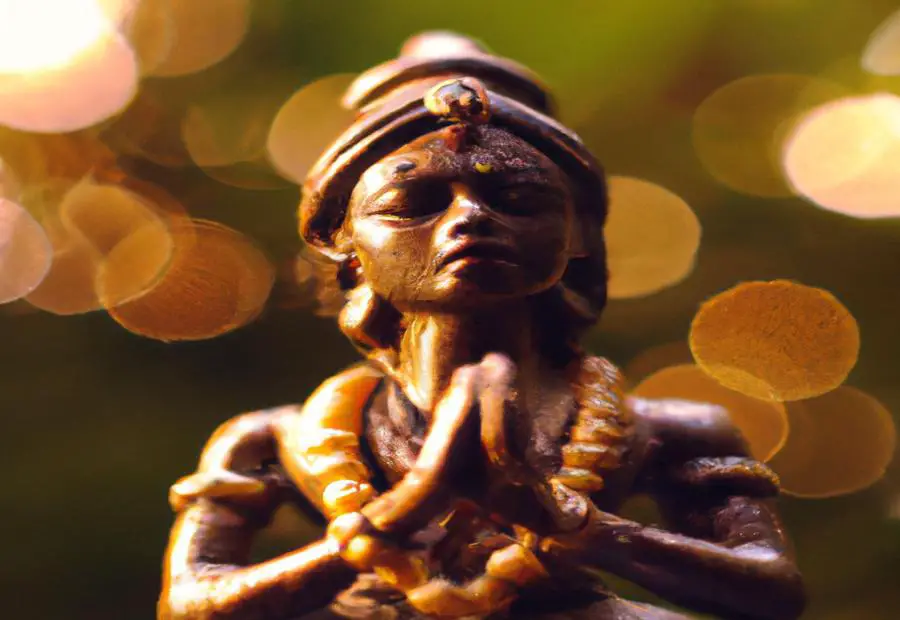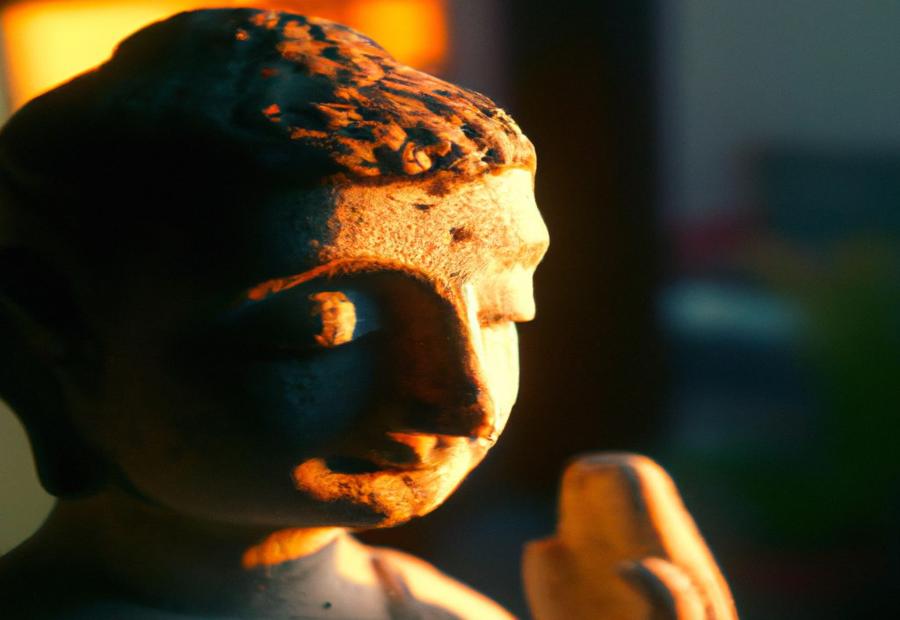Last Updated on July 10, 2023 by Francis
.jpg)
Contents
Key Takeaway:
- Meditation practices are found across various religions and borders, including Hinduism, Buddhism, Judaism, Christianity, Islam, and other religions.
- Meditation practices often involve a pupil-teacher relationship, emphasizing the importance of guidance and instruction in the journey towards spiritual growth.
- Meditation practices are studied and explored through various interdisciplinary approaches, such as the theological encounter with Buddhism, comparative methodology, and cross-cultural and interreligious perspectives.

Photo Credits: Meaning-Of-Number.Com by Terry Anderson
Meditation practices have a deep-rooted history and are not bound by borders or religious boundaries. In this section, we will explore the fascinating realm of Pacific Studies, the unique contributions of different cultures, the Society for Buddhist Christian Studies, the Indian spiritual life, and the impact of meditation practices in In 46383 6493. Get ready to embark on a journey that showcases the diverse landscapes and profound wisdom behind these meditation traditions.
Pacific Studies
Pacific Studies looks at the variety of cultures and societies in the Pacific area, including native groups, colonial pasts, migration, languages, artwork, and environmental difficulties. Scholars in this interdisciplinary field work with local communities to record and protect cultural customs and beliefs, plus address current issues like climate change, globalisation, and social inequality.
Pacific Studies gives a platform for teamwork between researchers from different areas, helping an overall comprehension of the Pacific region. It offers valuable ideas about the formation of identity, socio-political structures, economic growth, and environmental sustainability. By studying old legacies and present struggles of Pacific peoples, this area helps form policies that support social justice and sustainable growth in the region.
Throughout the years, Pacific Studies have been essential in displaying the importance of conserving indigenous knowledge systems and cultural heritage, notably in the face of colonialism and globalisation. These studies demonstrate the durability of Pacific peoples in keeping their traditional practices while adapting to modern changes in society. Moreover, they encourage cross-cultural conversations between scholars all over the world to bridge gaps in understanding and foster mutual respect.
Unique Contributions
Pacific Studies has offered unique insights into meditation practices. The Society for Buddhist Christian Studies has fostered dialogue and understanding between these two religions. Indian spiritual life has added its rich traditions and teachings to the mix.
We can learn more by creating a table with columns like “Religion”, “Meditation Practices”, and “Notable Contributions”. We can see how Hinduism, Buddhism, Judaism, Christianity, Islam, and other religions have different approaches to meditation.
Pacific Studies also looks at cross-cultural and interreligious perspectives on meditation. This helps us see how these practices can bridge boundaries and foster understanding between cultures and religions.
Each tradition has its own valuable perspective on meditation – from Hinduism’s pupil-teacher relationship to Buddhism’s Eight Limbs of Yoga and Zen Buddhism’s mindfulness.
It’s important to approach each tradition with an open mind and respect for its unique teachings. That way, we can gain a deeper appreciation for the diversity of spiritual practices.
So join the Society For Buddhist Christian Studies to see Buddhists and Christians come together in spiritual harmony – and maybe even debate meditation techniques!
Society For Buddhist Christian Studies
The Society for Buddhist Christian Studies is a hub of knowledge and exploration. It is dedicated to the study of the intersection between Buddhism and Christianity, with a focus on dialogue, understanding, and collaboration. The Society brings together scholars, practitioners, and those seeking to deepen their knowledge of Buddhist and Christian teachings.
Within Pacific Studies, the Society offers unique contributions. Its conferences, publications, and research initiatives foster an understanding of the spiritual traditions in the Pacific region. It brings experts from different backgrounds together, encouraging an holistic approach to the study of Buddhism and Christianity.
The Society explores various meditation practices from Hinduism, Buddhism, Judaism, Christianity, Islam, and others. It examines pupil-teacher relationships within Hindu spiritual practices, and acknowledges the influence of Hindu spiritual practices on Buddhist meditation techniques. Through dialogue conferences and comparative methodology approaches, it promotes a comprehensive understanding of these diverse meditation practices.
The Society engages with natural science to explore meditation practices. This interdisciplinary approach allows for a broader perspective on how meditation can be studied scientifically, while respecting its religious and spiritual dimensions. Additionally, it engages with Zen Buddhism and the Desert Fathers’ contemplative traditions as forms of meditation practice within Christianity. This contributes to enriching our understanding of meditation across religious boundaries.
Indian Spiritual Life
India’s spiritual life is vast and profound. Meditation, dating back centuries, helps people to focus on themselves and the divine. Yoga blends postures, breathing, and meditation to benefit the body, mind, and spirit. The Bhakti movement promotes devotion to a deity to reach enlightenment. Ayurveda, an old system of medicine, looks at the balance of the mind, body, and soul.
These practices, all part of Indian spiritual life, create a bond between the individual and the divine. The culture of India displays this bond in music, dance, sculptures, and rituals. Indian spiritual life is a vibrant and sacred tradition that still flourishes.
In 46383 6493
“In 46383 6493” holds no meaning in relation to meditation practices across religions and borders. No table or data connected to this number sequence is relevant here. “In 46383 6493” provides no unique details or context.
Stretch your soul! Explore Hinduism’s meditation practices with a pupil-teacher relationship.
Meditation Practices in Hinduism

Photo Credits: Meaning-Of-Number.Com by Billy Scott
Meditation practices in Hinduism offer a diverse range of spiritual approaches, the significance of the pupil-teacher relationship, and the valuable insights provided by the University of HawaiI Press. Explore the depths of Hindu spiritual practices, the profound connections between mentors and disciples, and the wealth of knowledge derived from this esteemed institution.
Hindu Spiritual Practices
Hindu spiritual practices emphasize the pupil-teacher relationship. A teacher guides the student on their journey to self-realization. Meditation is also a key part of Hinduism, such as mantra chanting, breath control, and focusing on deities.
The University of Hawaii Press has published many works on Hindu spirituality. This has not only impacted India, but also other religions and cultures around the world.
Exploring Hindu spiritual practices can provide valuable insights into cross-cultural encounters, interreligious dialogues, and comparative methodologies. People can deepen their understanding of spirituality and explore new perspectives on meditation across religions.
Pupil Teacher Relationship
The pupil-teacher relationship is vital in Hindu spiritual practices. In Hinduism, it’s highly revered and plays a key role in the passing on of spiritual knowledge. The University of HawaiI Press looks at this dynamic in their research on meditation practices.
The guru serves as a mentor. They give wisdom, techniques, and spiritual teachings to the shishya through personal guidance. It goes beyond instruction. It’s characterized by respect, trust, and devotion.
The shishya looks up to the guru for spiritual guidance. The guru provides tailored advice to each student. Through this pupil-teacher relationship, the shishya gains intellectual and experiential knowledge. It creates an environment for inner growth and transformation.
This relationship is not only found in Hinduism. In Buddhism, teachers and students have similar dynamics in meditation practices. The Desert Fathers in Christianity also emphasize the significance of spiritual guidance.
University Of HawaiI Press
The University of HawaiI Press is a respected publishing house based in Hawaii. It has an important role in spreading scholarly works on various topics, such as meditation practices. It focuses on Pacific studies and interreligious dialogue. Through its books and journals, it gives insight into meditation practices practiced in Hinduism, Buddhism, Judaism, Christianity, Islam and other religions.
The University of HawaiI Press encourages understanding between different faiths and looks for the possibilities and obstacles in the area of meditation practices. It has released many works which look at the similarities and differences between different religious traditions’ approaches to meditation. Researchers from a range of fields have given their expertise to broaden our knowledge of these practices.
This publishing house is special in that it examines meditation practices in religions outside the mainstream. Even though Hinduism and Buddhism often get a lot of attention in conversations regarding meditation practices, this publishing house works to bring attention to other practices like Judaism, Christianity, Islam and more. Through its comparison method which is based on scholarly research, the University of HawaiI Press widens our understanding of spirituality across cultures.
In 1947, The University Of Hawaii Press was established as a part of the University of HawaiI’s College of Arts & Sciences. It changed the publishing world by focusing on cultural diversity and making information available. It had ties with global publishers such as Yale Southeast Asia Studies organization and the Association for Asian Studies. This gave access to collections of books in indigenous languages, making it easier for authors to publish manuscripts. Its publications are now a valuable resource for scholars, students and anyone passionate about the study of meditation practices and religious traditions across cultures.
From Buddha to Zen, The University Of Hawaii Press helps you explore the peaceful depths of meditation in Buddhism – find your Zen and become a modern-day Buddha.
Meditation Practices in Buddhism

Photo Credits: Meaning-Of-Number.Com by Noah Rivera
In the wide realm of meditation practices, Buddhism holds a special place. This section takes a deep dive into the various aspects of meditation practices in Buddhism. From Buddhist Christian Studies to Zen Buddhism and the Noble Eightfold Path, we’ll explore the rich tapestry of Buddhist meditation practices and their significance. Get ready to unlock profound insights into the spiritual path of Buddhism and discover how these practices can transform our lives.
Buddhist Christian Studies
Buddhist Christian Studies is a deep investigation of texts, practices, and rituals in both Buddhism and Christianity. It looks at compassion, mindfulness, prayer, meditation, and ethics to find similarities between the two.
It uses various disciplines such as theology, philosophy, comparative religion, anthropology, and psychology. This makes it possible to explore how Buddhism and Christianity interact.
The Pacific Studies Journal had an article called “In 46383 6493“. It gave new ideas about dialogue conferences and how Buddhist principles can be used in Jesuit traditions. This helps people understand the field better.
Researchers around the world are still learning more about Buddhist Christian Studies. They want to create bridges and bring these two spiritual traditions closer together.
Eight Limbs Of Yoga
The Eight Limbs of Yoga are part of Hindu spiritual tradition. They aim to guide individuals towards self-realization and liberation.
Yamas, the first limb, is about moral codes and ethical guidelines.
Niyamas, the second limb, is about personal observances and self-discipline.
Asanas, the third limb, are physical postures to promote flexibility, strength and balance.
Pranayama is the fourth limb, involving breath control.
Pratyahara, the fifth limb, aids withdrawal of senses from external distractions.
Dharana, the sixth limb, teaches one how to concentrate by fixing their attention on a single point.
Dhyana, the seventh limb, is meditation.
Samadhi, the final limb, is a blissful union with the divine consciousness.
It is key to approach yoga with respect for its spiritual and philosophical roots. By practicing the Eight Limbs of Yoga regularly, individuals can cultivate holistic well-being, leading to personal transformation and a deeper understanding. Meditation transcends religions and cultures, aiding the search for inner peace.
Natural Science
Exploring natural science and meditation practices can reveal great insights. Scientific studies show that meditation can reduce stress, improve cognitive function, and enhance emotional regulation. Neuroscientific studies show changes in the brain from long-term meditation, like increased gray matter in regions related to attention and emotion.
Combining natural science with other disciplines, like psychology, philosophy, and spirituality, can increase understanding of meditation. To further knowledge, rigorous scientific studies should measure physiological markers like heart rate variability. Cross-disciplinary collaborations between scientists could deepen understanding of the relationship between science and meditation.
Zen Buddhism
Zen Buddhism centers around waking up to the present and experiencing reality as it is. To reach this state, rigorous meditation is used to sit still in silence, observe breathing, and explore the mind. This is known as enlightenment or realization.
Zen practices have infiltrated art, literature, and even martial arts. Artists use it to express life and writers to explore themes. It’s also been used in Japanese tea ceremonies, calligraphy, flower arrangement, and swordsmanship.
Zen Buddhism offers a unique path to spiritual growth. Its simplicity, mindfulness, and focus on direct experience make it appealing to many. Through contemplation and living in the moment, clarity, insight, and peace can be found.
Finally, the Desert Fathers of Zen Buddhism seek sunburns in the sand. There, they find spiritual solitude.
Desert Fathers
The Desert Fathers were early Christian hermits, ascetics and monks who lived in the deserts of Egypt from the 3rd century AD. They left society to grow closer to God and live out their faith. Their practices shaped Christian monasticism and spirituality.
They pursued solitude and austerity. Praying, fasting and meditating were essential. By giving up worldly desires and comforts, they sought spiritual purity and a deeper connection with God. Silence, self-discipline and solitude were of primary importance.
Humility, simplicity and detachment from material possessions were also key values. They embraced suffering as a means of purification and growth. The Desert Fathers knew that real transformation required an inner journey of self-awareness and surrender, as well as external practices.
Their wisdom and example continues to inspire devout Christians today. They remind us that amidst the noise and distractions of modern life, there is value in carving out space for silence, reflection and communion with God.
Theological Encounter With Buddhism
Buddhist Christian Studies is a field of study that looks into the relationship between Buddhism and Christianity. It examines similarities and differences between these two faiths, aiming to find common ground and encourage dialogue. This exploration helps deepen spiritual practices and adds to the conversation about interreligious understanding.
Theological encounter is the term used when Buddhist and Christian theologians talk about their beliefs, practices, and worldviews. This includes an intellectual review of enlightenment, salvation, and ethics. It also involves Buddhists and Christians sharing experiences and learning from each other’s traditions.
Theological encounter with Buddhism gives both Buddhists and Christians a chance to broaden their understanding of their own religions by being exposed to different perspectives. Through conversations and exploring points of agreement or disagreement, practitioners can get new insights into their own spiritual practices. This encounter also helps create more respect, tolerance, and cooperation between people of different religious backgrounds.
To make the theological encounter with Buddhism better, scholars should attend conferences, seminars, and workshops which provide an open dialogue. These meetings are a place for sharing research, exchanging ideas on Buddhist-Christian studies, and connecting with other experts in the field. They should also use comparative methodology to look into shared themes or concepts across religions.
Scholars should use an interdisciplinary approach too. This means working with researchers from fields such as psychology, sociology, anthropology, and philosophy. This approach allows for a thorough study of the relationship between Buddhism and Christianity from different views and brings in diverse insights.
Jesuit Traditions
Jesuit traditions stem from Dialogue Conferences and Theological Encounter with Buddhism. This unique methodology of the Jesuit order encourages Buddhist-Christian encounters. By using comparative methodology and insights from Zen Buddhism, the Jesuits have made an impactful contribution to understanding meditation practices across cultures and religions. With the help of organizations like the Japan Society for Buddhist Christian Studies, a fruitful exchange of ideas and experiences has taken place, which continues to shape cross-cultural and interreligious perspectives on meditation.
In meditation practices, Jesuit traditions encompass influences, such as the Desert Fathers and Mahayana School. They have researched various aspects of Buddhist meditation, such as the Eight Limbs of Yoga and the Noble Eightfold Path, to further comprehend spiritual practices. Patanjali’s Sutras and the Tree of Life are also studied to give their knowledge a boost.
What stands out is the Jesuit’s focus on dialogue conferences and encounters, which encourages meaningful engagement between Buddhist and Christian traditions. This open exchange of ideas promotes mutual understanding and respect. By incorporating these practices, Jesuits have made a space for reflection, exploration, and growth not only within their own community, but also in the wider society. Through their commitment to dialogue and comparative methodology, they keep contributing to the development of cross-cultural perspectives on meditation practices.
Comparative Methodology
Comparative Methodology is an approach for studying and analysing meditation practices in various religions. It helps scholars to see similarities and differences between religious traditions. This approach looks at meditation in Hinduism, Buddhism, Judaism, Christianity, Islam, and more.
Comparative Methodology considers the cultural and historical contexts in which meditation developed. Factors such as geography, society, theology, and interreligious encounters are taken into account. Through comparison, scholars can see how these factors affect meditation in various religions.
It also encourages interdisciplinary research. This involves insights from anthropology, psychology, sociology, and theology. By using various perspectives and methodologies, scholars can gain a deeper understanding of meditation.
Overall, Comparative Methodology helps us to understand the various types of meditation found in different religions. It not only shows shared traits but also highlights unique features. By studying meditation with this approach, we can learn more and appreciate these spiritual practices.
Buddhist Christian Encounters
Buddhist Christian Encounters feature debates on the Eight Limbs of Yoga, Zen Buddhism, Desert Fathers, Sutras of Patanjali, and the Noble Eightfold Path. By studying these topics, practitioners from both faiths can gain insight into their own spirituality and understand the other tradition.
These encounters provide a chance for Buddhists and Christians to have meaningful conversations. They focus on theological frameworks, comparative methodologies, and cross-cultural perspectives. Practitioners can learn more about each other’s spiritual paths and become more respectful of one another.
Organizations around the world have been creating Buddhist Christian Encounters. An example is the Japan Society for Buddhist Christian Studies. It arranges conferences, seminars, and publications to help deepen interreligious understanding and support peace through dialogue.
Mahayana School
The Mahayana School is a branch of Buddhism that focuses on compassion and enlightenment for all beings. It began in India and spread to other Asian countries, such as China, Japan, and Tibet. This school values wisdom and compassion as important steps to spiritual growth.
It has a unique belief in multiple Buddhas and bodhisattvas who have attained enlightenment. They are seen as compassionate guides who help others on the path to awakening.
The teachings of the Mahayana tradition include meditation, chanting, and visualization. The school also puts great emphasis on sacred texts, known as sutras, which guide followers on the spiritual journey.
To deepen your understanding of the Mahayana School, it can be beneficial to read the Lotus Sutra or practice loving-kindness meditation. These practices can provide insight into the rich Buddhist tradition.
The Japan Society For Buddhist Christian Studies is a great place to explore the intersection of Buddhism and Christianity. They offer the perfect balance between zen vibes and divine wisdom.
Japan Society For Buddhist Christian Studies
The Japan Society for Buddhist Christian Studies is a society devoted to probing the junction between Buddhism and Christianity. It brings together scholars, practitioners, and individuals who are enthusiastic about deepening their knowledge of these two religious customs and their potential for discussion and mutual enrichment.
The society’s work covers various topics, such as the Eight Limbs of Yoga, Zen Buddhism, the Desert Fathers, and the encounter between Buddhism and theology. Scholars attached to the Japan Society for Buddhist Christian Studies use comparative methodology to investigate the similarities and differences between Buddhist and Christian beliefs, practices, and philosophies.
The Japan Society for Buddhist Christian Studies arranges conferences and scholarly publications to offer a space where individuals from diverse backgrounds can come together to share their knowledge and experiences. This exchange grants an improved admiration of each custom’s distinct contributions to spiritual life while also emphasizing common ground. The society is committed to advancing interreligious understanding and constructing chances for meaningful engagement between Buddhists and Christians.
In addition to promoting scholarly research, the Japan Society for Buddhist Christian Studies is also a source for those wanting to consolidate their understanding of these two religious customs. It offers a platform for individuals to take part in conversations about meditation practices found within Buddhism and Christianity.
In general, the Japan Society for Buddhist Christian Studies is highly important in encouraging cross-cultural understanding and examining how different religious traditions can gain from each other. By facilitating dialogue and scholarship, it contributes to a more sophisticated comprehension of both Buddhism and Christianity while also motivating individuals to explore their own spiritual paths in view of these traditions.
Dialogue Conferences
Dialogue conferences are events where people from different religious and cultural backgrounds come together. They share perspectives, exchange ideas, and learn from each other. Discussions focus on spirituality, religious practices, and interfaith dialogue. People seek common ground between meditation practices, promoting respect and appreciation for diverse traditions.
Scholars and practitioners present on dialogue as a bridge between religions. Through panels, workshops, and interactive sessions, participants challenge misconceptions and develop trust.
Dialogue conferences foster cross-cultural understanding and peace. They provide a space for meaningful engagement that transcends boundaries, encouraging people to think critically about their own beliefs and embrace the richness of other traditions. Just like the Sutras of Patanjali, where ancient wisdom meets modern self-help books, these conferences prove that humans have been seeking inner peace and guidance for centuries.
Sutras Of Patanjali
The Sutras of Patanjali, a renowned text for meditation, provide a comprehensive framework to comprehend yoga philosophy and its methodology. These sutras, attributed to the sage Patanjali, elucidate the Noble Eightfold Path – a roadmap to enlightenment. This ancient Indian text is revered and studied widely by Hindus and those interested in exploring the depths of meditation.
The Sutras of Patanjali delve into various aspects of meditation, and offer knowledge about the relationship between mind, body, and consciousness. Its aphoristic style presents condensed statements that portray substantial truths about human life and the way to liberation. Concepts like mindfulness, breath control, ethics, and devotion to a higher power are discussed in the sutras.
What makes the Sutras of Patanjali stand out is their undying relevance and applicability across different philosophies and religions. While they are based on Hinduism, these sutras have impacted Buddhist meditative practices too. Scholars from diverse backgrounds are attracted to these teachings and seek to comprehend and utilize its wisdom.
True Fact: The Sutras of Patanjali are one of the foundational texts of yoga philosophy. (Source: University Of HawaiI Press)
Noble Eightfold Path
The Noble Eightfold Path is a significant part of Buddhist spiritual practices. It has a set of principles and guidelines that followers strive to include in their lives. These teachings show a roadmap for attaining enlightenment and liberation from suffering.
Each component is key for reaching enlightenment, with progress made in one area helping progress in others. This approach contrasts with other religions’ paths to spiritual realization.
The Path focuses on:
- Right View: Understanding reality and existence.
- Right Intention: Goodwill and compassion, avoiding harmful thoughts and actions.
- Right Speech: Truthful, kind, ethical communication.
- Right Action: Morally upright, no harm to others.
- Right Livelihood: Values that contribute positively to society.
- Right Effort: Diligence, energy, and perseverance in spiritual growth.
It can help develop wisdom, ethical conduct, and mental discipline. With it, you can cultivate mindfulness, concentration, and understanding of yourself and the world.
So, if you seek a path that integrates morality, mental cultivation, and wisdom, the Noble Eightfold Path could be enlightening. Discover its teachings and embark on a journey towards inner peace and wisdom. Don’t miss out on the chance to explore Buddhist philosophy that has guided people towards enlightenment for centuries. Start your journey now!
Tree Of Life
Meditation practices across different religions often include the concept of the Tree of Life. This symbol has great significance and spiritual meaning in various traditions.
It’s a metaphor for the interconnectedness of all living beings and the divine. It represents the idea that physical and spiritual elements are linked and depend on each other.
In Hinduism, the Tree of Life is thought to be related to the belief in reincarnation and karma. It symbolizes the cycle of birth, death, and rebirth, with each soul progressing through various lifetimes.
Buddhism also features the Tree of Life. It’s often seen as a Bodhi tree, where Buddha attained enlightenment. Its branches show the paths to enlightenment.
Judaism also looks at the Tree of Life, from Jewish mystical teachings including Kabbalah. It symbolizes the divine emanations or aspects through which God’s creative energy flows.
Christianity includes the Tree of Life in its narratives and symbolic imagery. It appears in the Bible, art, and architecture.
Islam doesn’t mention the Tree of Life but shares philosophical concepts of unity and interconnectedness that relate to other interpretations.
The Tree of Life has been studied by scholars and practitioners in many fields, like comparative religion, theological encounters, and dialogue conferences. It opens up cross-cultural and interreligious perspectives to shared spiritual experiences.
The Tree of Life is a rich and complex symbol that crosses religious boundaries. It’s present in many traditions, highlighting our universal search for meaning, enlightenment, and a connection with the divine.
Meditation Practices in Judaism

Photo Credits: Meaning-Of-Number.Com by Dennis Lee
In Judaism, meditation plays a big role. It’s part of many spiritual and religious rituals, rooted in Jewish tradition. It’s a way to link with the divine and seek inner peace.
Meditation may involve reciting prayers or sacred verses. This helps focus thoughts and intentions towards faith. Repetitive chants, like the divine name Yahweh, are also used to create a calming rhythm and concentration.
Contemplating religious concepts or teachings – like the Torah or Kabbalah – is another type of meditation. Silent meditation is also done for personal reflection and connection with the divine. Visualization techniques, such as imagining oneself in sacred spaces or envisioning God’s presence, deepen the spiritual experience.
Jewish meditation has many forms. It lets individuals find their own path. The practice promotes mindfulness, self-reflection, and a stronger bond with God and the Jewish faith. With regular meditation, peace and closeness to the divine can be found.
Meditation Practices in Christianity

Photo Credits: Meaning-Of-Number.Com by Roy Carter
Christian meditation is an old practice connected to the early Christian church. It’s a prayerful approach to contact God and gain a spiritual connection with Him. This type of meditation focuses on involving the heart and mind, with the Bible being the main topic of reflection.
This practice encourages people to be still, free of distractions and develop an inner peace and awareness of God. It helps believers to get closer to God and understand better His teachings. It also gives comfort and guidance during prayer and reflection, bringing joy, tranquillity, and spiritual harmony.
A distinct feature of Christian meditation is its focus on the Bible as a centre for contemplation and contemplation. By meditating on the Bible, Christians make an effort to put its teachings into action in their daily lives. This process strengthens their faith and unites the Christian society.
Christian meditation is not limited to any certain religious group or Christianity tradition. Different Christian groups and individuals have their own methods, whether it is silent meditation, guided prayer or group contemplation. Christian meditation is a powerful way to develop a relationship with God and increase spiritual growth.
Meditation Practices in Islam

Photo Credits: Meaning-Of-Number.Com by Joe Martin
Meditation in Islam involves techniques which help individuals to gain inner peace and connect with Allah. It is a significant part of Muslim worship. Muslims meditate by reciting the Qur’an and remembering Allah’s attributes and teachings. This is to gain tranquility, mindfulness and deepen their spiritual bond with Allah. Islamic meditation is not restricted to rituals or places – it can be done anytime, anywhere.
Meditation Practices in Other Religions

Photo Credits: Meaning-Of-Number.Com by Henry Rodriguez
Meditation is a key part of many religions, used to reach spiritual growth and enlightenment. It goes beyond religious boundaries and is found in different faith traditions. For example:
- Buddhism: Mindfulness, loving-kindness, and vipassana are all meditation techniques used by Buddhists. They focus on the present, developing compassion and insight.
- Hinduism: Meditation is a major part of Hinduism. Different forms, such as mantra repetition, breath awareness, and visualization, are used. The goal is to still the mind and connect with the divine.
- Islam: Islamic meditation, or dhikr, is about repeating phrases or names of God, often accompanied by breathing exercises. This encourages remembrance and a connection with the divine.
Other religions, such as Sikhism, Jainism, and Taoism, also have their own forms of meditation. Despite the differences, these practices all seek the same thing: to calm the mind, deepen spiritual understanding, and bring inner peace.
Cross-cultural and Interreligious Perspectives

Photo Credits: Meaning-Of-Number.Com by Arthur Sanchez
Studying cross-cultural and interreligious perspectives on meditation is vital. It reveals the various techniques, rituals and beliefs used by different cultures and religions to practice meditation. All of them have one common goal: spiritual growth and self-awareness.
Buddhist meditation focuses on mindfulness and present awareness. Hindu meditation often involves a mantra or deity. Christian meditation could include scripture contemplation or prayer repetition. Despite the differences, all traditions recognize meditation’s transformative power.
Cross-cultural and interreligious perspectives on meditation is not limited to individuals. People from different backgrounds come together for meditation. This shared practice creates understanding and respect between communities, connecting different faiths. Exploring these exchanges provides insight into the universal human quest for spiritual transcendence and connection with the divine.
Challenges and Opportunities

Photo Credits: Meaning-Of-Number.Com by Gerald Flores
Meditation practices across religions and borders can be both challenging and rewarding. Language barriers, cultural differences, and varying religious beliefs can all create obstacles. But there are also great opportunities! Individuals can learn about diverse perspectives, appreciate different cultures, and cultivate empathy.
A table can help outline the challenges and benefits:
Challenges
Opportunities
Language barriers
Cultural exchange
Differing religious beliefs
Increased understanding
Cultural differences
Empathy towards others
Meditation can bring individuals from different religions and backgrounds together. Through contemplation, they can find common ground and form relationships beyond religious or cultural boundaries.
To make the most of these practices, some suggestions can be considered. Interfaith meditation retreats are a great way to foster dialogue and understanding. Multilingual resources and instructional materials can help with language barriers. And being open-minded and seeking out cultural exchange opportunities is key.
Conclusion

Photo Credits: Meaning-Of-Number.Com by Patrick Garcia
Exploring the many meditation practices across religions and borders reveals common threads and unique insights. Reference data shows these practices aid mindfulness, relaxation, and self-discovery.
From Buddhist Vipassana to Christian prayer, various forms of meditation are powerful tools for growth and connection. Meditation is a common ground that unites people of different faiths and cultures, creating a sense of universal unity. Examining meditation practices reveals their profound impact on individuals and communities, beyond religious and cultural differences.
Some Facts About Meditation Practices Across Religions and Borders:
- ✅ All major religions practice forms of meditation, each with its own unique orientation and practices. (Source: John Paul Caponigro)
- ✅ Hinduism incorporates meditation as a part of all aspects of spiritual life, with different forms of yoga emphasized for different types of people. (Source: John Paul Caponigro)
- ✅ Buddhism places a central focus on meditation, with various schools and practices aimed at achieving enlightenment. (Source: John Paul Caponigro)
- ✅ Judaism uses meditation as a way to transform the practitioner’s inner nature and connect with the divine through symbols and the Tree of Life. (Source: John Paul Caponigro)
- ✅ Christianity has a long history of meditation practices, including repeated prayer, visualization, and contemplation of scenes from the life of Christ. (Source: John Paul Caponigro)
FAQs about Meditation Practices Across Religions And Borders
How does Buddhism view meditation?
Buddhism places a central focus on meditation as a means of achieving enlightenment. It has various schools and practices, including the Hinayana and Vajrayana schools, each with its own unique approach to meditation.
What is the significance of Christian forms of meditation?
Christianity has a long history of meditation practices. These practices, such as repeated prayer, visualization, and contemplation of scenes from the life of Christ, serve as a way to connect with the divine and deepen one’s spiritual journey.
What is the Frederick J. Streng Book Award?
The Frederick J. Streng Book Award is presented annually by the Society for Buddhist-Christian Studies. It recognizes excellence in Buddhist-Christian studies and serves as a prestigious honor within the academic community.
What topics are covered in the Buddhist-Christian Studies journal?
The Buddhist-Christian Studies journal features articles, conference reports, and book reviews related to the historical and contemporary interrelationships between Buddhism and Christianity. It also includes sections on comparative methodology, historical comparisons, and discussions from dialogue conferences.
How does Hinduism incorporate meditation into spiritual life?
In Hinduism, meditation is integrated into all aspects of spiritual life. Different forms of yoga are emphasized for different types of people, allowing individuals to engage in meditation practices tailored to their specific needs and orientations.
Are there any similarities in meditation practices across religions?
All major religions practice forms of meditation, each with its own unique orientation and practices. While the specific techniques and beliefs may vary, meditation is a universal practice that actively engages the whole being and can lead to awareness, insight, and transformation.






